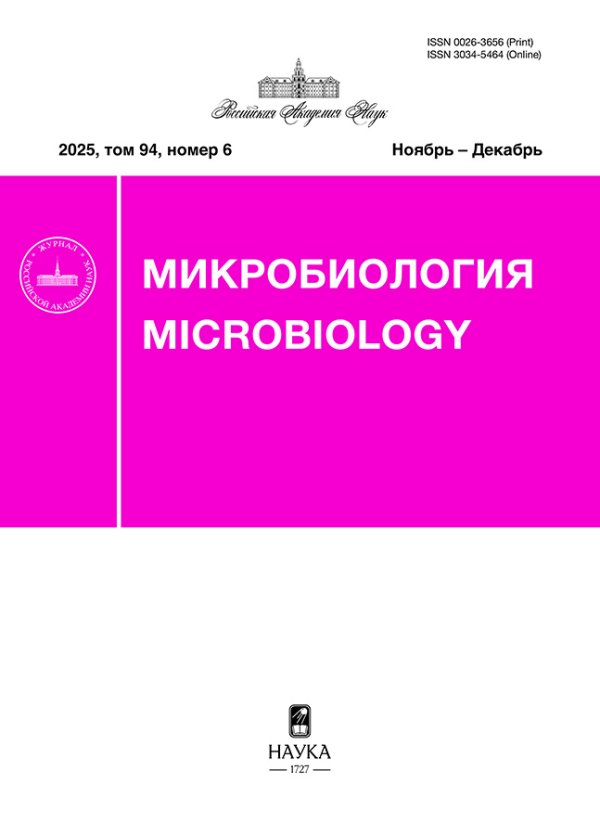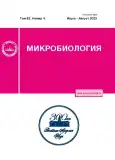Role of the Structural and Functional Genes Encoding Heat Shock Proteins in Biosurfactant Synthesis by Rhodococcus pyridinivorans 5Ap
- Authors: Bukliarevich H.A.1, Titok M.A.1
-
Affiliations:
- Belarusian State University,
- Issue: Vol 92, No 4 (2023)
- Pages: 366-375
- Section: EXPERIMENTAL ARTICLES
- URL: https://journals.rcsi.science/0026-3656/article/view/138207
- DOI: https://doi.org/10.31857/S0026365623600049
- EDN: https://elibrary.ru/RIYXOI
- ID: 138207
Cite item
Full Text
Abstract
Abstract—The role of groESL and dnaJ structural genes and hrcA regulatory gene, encoding the synthesis of heat shock proteins, in biosurfactant synthesis by R. pyridinivorans 5Ар was determined. The CIRCE binding sites for the regulatory protein coded by hrcA gene were revealed in the promoter regions of groESL, groEL2, and fmdB genes. GroESL and groEL2 genes expression during the late exponential phase in the medium with hexadecane at 42°C was higher than at 28°C (4.4 and 5.3 times, respectively). At the same time, no changes in expression of hrcA and fmdB genes were observed at two different temperature modes (28 and 42°C). In the absence of the negative regulator HrcA, groESL expression increased 14.4 and 3.5 times, that of groEL2, 9.6 and 2.7 times, and that of fmdB, 1.82 and 2.52 times at 28 and 42°C, respectively. Products of dnaJ and hrcA genes were required for trehalolipid synthesis at different temperature modes, with their role increasing at higher temperature (synthesis of trehalolipids by the mutant with impaired dnaJ gene decreased 1.8 and 2.5 times compared to 1.5 and 6.6 times, for the mutant with impaired hrcA at 28 and 42°C, respectively). At the same time, emulsifying activity of all mutant variants did not change at 28°C and decreased 1.4 and 1.9 times 42°C for the mutants with impaired groESL and hrcA genes, respectively. Our results indicated the complex chemical nature of the biosurfactants produce by R. pyridinivorans 5Ар (emulsifiers, including trehalolipids and compounds of other chemical composition). The Gro chaperones and the HrcA regulatory protein play the key roles in synthesis of these compounds at different temperature modes, while the dnaJ is required only for trehalolipid synthesis.
Keywords
About the authors
H. A. Bukliarevich
Belarusian State University,
Email: ma_titok@bsu.by
Belarus, 220030, Minsk
M. A. Titok
Belarusian State University,
Author for correspondence.
Email: ma_titok@bsu.by
Belarus, 220030, Minsk
References
- Букляревич А.А., Чернявская М.И., Охремчук А.Э., Валентович Л.Н., Титок М.А. Влияние структурных и регуляторных белков теплового шока на деградацию углеводородов бактериями Rhodococcus pyridinivorans 5AP // Микробиология. 2019. Т. 88. С. 553‒561.
- Bukliarevich H.A., Charniauskaya M.I., Akhremchuk A.E., Valentovich L.N., Titok M.A. Effect of the structural and regulatory heat shock proteins on hydrocarbon degradation by Rhodococcus pyridinivorans 5Ap // Microbiology (Moscow). 2019. V. 88. P. 573–579.
- Букляревич А.А., Гуринович А.С., Филонов А.Е., Титок М.А. Молекулярно-генетический и функциональный анализ генов бактерий рода Rhodococcus, кодирующих синтез алкан-1-монооксигеназ // Микробиология. 2023. Т. 92. С. 1–15.
- Bukliarevich H.A., Gurinovich A.S., Filonov A.E., Titok M.A. Molecular-genetic and functional analysis of genes of Rhodococcus bacteria encoding synthesis alkan-1-monooxygenase // Microbiology. 2023. V. 92. № 2. P. 1–15.
- Пирог Т.П., Шевчук Т.А., Клименко Ю.А. Интенсификация синтеза поверхностно-активных веществ при культивировании Rhodococcus erythropolis ЭК-1 на гексадекане // Прикл. биохимия и микробиология. 2010. Т. 46. С. 651‒658.
- Pirog T.P., Shevchuk T.A., Klimenko I.A. Intensification of surfactant synthesis in Rhodococcus erythropolis EK-1 cultivated on hexadecane // Appl. Biochem. Microbiol. 2010. V. 46. P. 599–606.
- Becker S.H., Ulrich K., Dhabaria A., Ueberheide B., Beavers W., Skaar E.P., Iyer L.M., Aravind L., Jakob U., Darwin K.H. Mycobacterium tuberculosis Rv0991c is a redox-regulated molecular chaperone // mBio. 2020. V. 11. e01545-20.
- Blumenstein J., Rädisch R., Štěpánek V., Grulich M., Dostálová H., Pátek M. Identification of Rhodococcus erythropolis promoters controlled by alternative sigma factors using in vivo and in vitro systems and heterologous RNA polymerase // Curr. Microbiol. 2022. V. 79. Art. 55.
- Cooper D.G., Goldenberg B.G. Surface-active agents from two Bacillus species // Appl. Environ. Microbiol. 1987. V. 53. P. 224–229.
- Coppens L., Lavigne R. SAPPHIRE: a neural network-based classifier for σ70 promoter prediction in Pseudomonas // BMC Bioinform. 2020. V. 21. Art. 415.
- DuBois M., Gilles K.A., Hamilton J.K., Rebers P.A., Smith Fred. Colorimetric method for determination of sugars and related substances // Anal. Chem. 1956. V. 28. P. 350–356.
- Ferreira A., O’Byrne C.P., Boor K.J. Role of ςB in heat, ethanol, acid, and oxidative stress resistance and during carbon starvation in Listeria monocytogenes // Appl. Environ. Microbiol. 2001. V. 67. P. 4454–4457.
- Hu Y., Oliver H.F., Raengpradub S., Palmer M.E., Orsi R.H., Wiedmann M., Boor K.J. Transcriptomic and phenotypic analyses suggest a network between the transcriptional regulators HrcA and σB in Listeria monocytogenes // Appl. Environ. Microbiol. 2007. V. 73. P. 7981–7991.
- Iwabuchi N., Sunairi M., Anzai H., Nakajima M., Harayama S. Relationships between colony morphotypes and oil tolerance in Rhodococcus rhodochrous // Appl. Environ. Microbiol. 2000. V. 66. P. 5073–5077.
- Jung J., Noh J., Park W. Physiological and metabolic responses for hexadecane degradation in Acinetobacter oleivorans DR1 // J. Microbiol. 2011. V. 49. P. 208–215.
- Kaczorek E., Pacholak A., Zdarta A., Smulek W. The impact of biosurfactants on microbial cell properties leading to hydrocarbon bioavailability increase // Colloids and Interfaces. 2018. V. 2. Art. 35.
- Kato T., Miyanaga A., Kanaya S., Morikawa M. Alkane inducible proteins in Geobacillus thermoleovorans B23 // BMC Microbiol. 2009. V. 9. Art. 60.
- Kuyukina M.S., Ivshina I.B. Rhodococcus Biosurfactants: biosynthesis, properties, and potential applications // Biology of Rhodococcus, Microbiology Monographs / Ed. Alvarez H.M. Berlin, Heidelberg: Springer, 2010. P. 291–313.
- Kuyukina M.S., Ivshina I.B., Philp J.C., Christofi N., Dunbar S.A., Ritchkova M.I. Recovery of Rhodococcus biosurfactants using methyl tertiary-butyl ether extraction // J. Microbiol. Methods. 2001. V. 46. P. 149–156.
- Larkin M.J., Kulakov L.A., Allen C.C.R. Biodegradation and Rhodococcus-masters of catabolic versatility // Curr. Opin. Biotechnol. 2005. V. 16. P. 282–290.
- Nie Y., Chi C.-Q., Fang H., Liang J.-L., Lu S.-L., Lai G.-L., Tang Y.-Q., Wu X.-L. Diverse alkane hydroxylase genes in microorganisms and environments // Sci. Rep. 2014. V. 4. Art. 4968.
- Okonechnikov K., Golosova O., Fursov M. The UGENE team. Unipro UGENE: a unified bioinformatics toolkit // Bioinformatics. 2012. V. 28. P. 1166–1167.
- Ortiz de Orué Lucana D., Wedderhoff I., Groves M.R. ROS-mediated signalling in bacteria: zinc-containing Cys-X-X-Cys redox centres and iron-based oxidative stress // J. Signal Transduct. 2012. V. 2012. Art. 605905.
- Pátek M., Grulich M., Nešvera J. Stress response in Rhodococcus strains // Biotechnol. Adv. 2021. V. 53. Art. 107698.
- Pfaffl M.W. A new mathematical model for relative quantification in real-time RT-PCR // Nucl. Acids Res. 2001. V. 29. Art. e45.
- Riele H. te, Michel B., Ehrlich S.D. Single-stranded plasmid DNA in Bacillus subtilis and Staphylococcus aureus // Proc. Natl. Acad. Sci. USA. 1986. V. 83. P. 2541–2545.
- Roncarati D., Danielli A., Scarlato V. The HrcA repressor is the thermosensor of the heat-shock regulatory circuit in the human pathogen Helicobacter pylori // Mol. Microbiol. 2014. V. 92. P. 910–920.
- Roncarati D., Scarlato V. Regulation of heat-shock genes in bacteria: from signal sensing to gene expression output // FEMS Microbiol. Rev. 2017. V. 41. P. 549–574.
- Sambrook J., Fritsch E.F., Maniatis T. Molecular Cloning: A Laboratory Manual. Cold Spring Harbor, NY: Cold Spring Harbor Laboratory Press, 1989.
- Schäfer A., Tauch A., Jäger W., Kalinowski J., Thierbach G., Pühler A. Small mobilizable multi-purpose cloning vectors derived from the Escherichia coli plasmids pK18 and pK19: selection of defined deletions in the chromosome of Corynebacterium glutamicum // Gene. 1994. V. 145. P. 69–73.
- Schumann W. Regulation of bacterial heat shock stimulons // Cell Stress Chaperones. 2016. V. 21. P. 959–968.
- Solovyev V., Salamov A. Automatic annotation of microbial genomes and metagenomic sequences // Metagenomics and Its Applications in Agriculture, Biomedicine and Environmental Studies / Ed. Li R.W. Nova Science Publishers, 2011. P. 61‒78.
- Sutcliffe I., Brown A., Dover L. The rhodococcal cell envelope: composition, organisation and biosynthesis // Biology of Rhodococcus. Microbiology Monographs / Ed. Alvarez H.M. Berlin, Heidelberg: Springer, 2010. P. 29–71.
- Takihara H., Ogihara J., Yoshida T., Okuda S., Nakajima M., Iwabuchi N., Sunairi M. Enhanced translocation and growth of Rhodococcus erythropolis PR4 in the alkane phase of aqueous-alkane two phase cultures were mediated by GroEL2 overexpression // Microbes Environ. 2014. V. 29. P. 346–352.
Supplementary files















